US Pharmaceutical Logistics Market Size
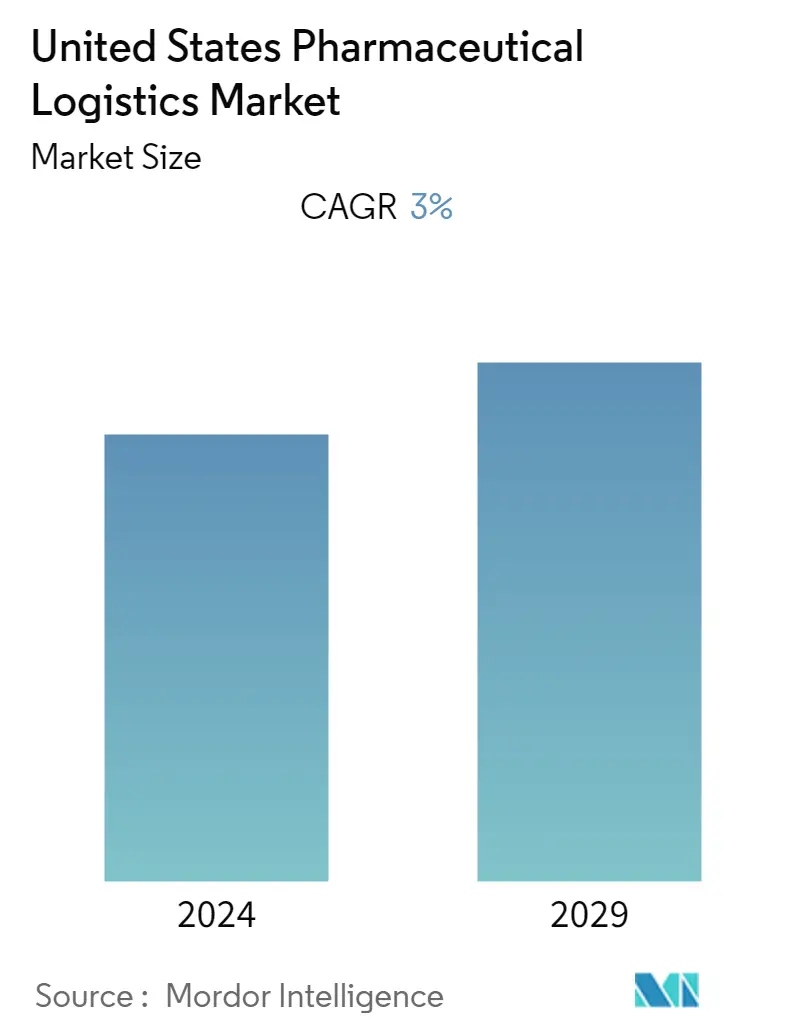
| Study Period | 2019 - 2029 |
| Base Year For Estimation | 2023 |
| Forecast Data Period | 2024 - 2029 |
| Historical Data Period | 2019 - 2022 |
| CAGR | 3.00 % |
| Market Concentration | Medium |
Major Players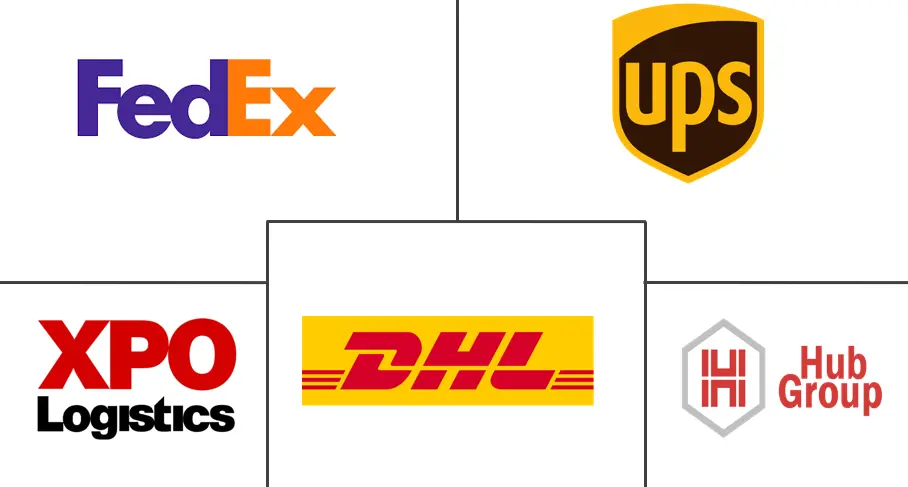
*Disclaimer: Major Players sorted in no particular order |
US Pharmaceutical Logistics Market Analysis
The United States Pharmaceutical Logistics Market is estimated to register a CAGR of 3% during the forecasted time period.
- Transportation problems were making it hard to distribute COVID-19, which was causing problems in the drug supply chain.Port disruptions, quarantined personnel, and labor shortages caused by lockdowns were all factors. Furthermore, COVID-19 slowed the development of new pharmaceutical products due to material shortages, interruptions in clinical trials, and delays in FDA clearance. Customers were more inclined to stay at home and avoid in-person pharmacies to avoid infection; therefore, distribution efforts turned primarily to at-home delivery systems, such as internet pharmacies and assistive applications.
- In the United States, there has been a big increase in the production of generic drugs because they are cheaper than brand-name drugs and don't need as much research and testing.Generic drugs have also helped keep the country's health care system going by making it easier for patients to get the care they need and saving money for taxpayers, employers, and insurance companies.As a result, the US government is pushing the use of generic pharmaceuticals in order to reduce the country's healthcare spending.
- Pharmaceutical distributors are at the core of the healthcare ecosystem in the United States. Distributors manage 92% of pharmaceutical sales, bringing efficiency and order to a supply chain that connects two extremely fragmented markets: 1,300 manufacturers and 180,000+ points of sale. With the increased shipment of medicines, life sciences, and medical devices throughout the world, the majority of it is coming from the United States and Europe.
- Even though regulations are getting stricter, the biopharmaceutical industry is sending more shipping and distribution jobs to third-party logistics firms. Because of this, electronic cargo monitoring, which includes reporting on where the cargo is and how it is doing in almost real time, is becoming a popular alternative.
US Pharmaceutical Logistics Market Trends
This section covers the major market trends shaping the US Pharmaceutical Logistics Market according to our research experts:
Growing Pharmaceutical Industry in the Country
The United States is the world's leader in pharmaceutical R&D. As of November 2021, the United States' share of the total global pharmaceutical value stood at 40 percent of the pharmaceutical industry worldwide, while China's share stood at 12 percent.
The US government's plan to implement cost control policies, along with the tightening of government rules like the delay in the approval of complex generics and price erosion in the United States generic pharmaceutical market, is expected to impact the growth prospects of the United States pharmaceutical industry.
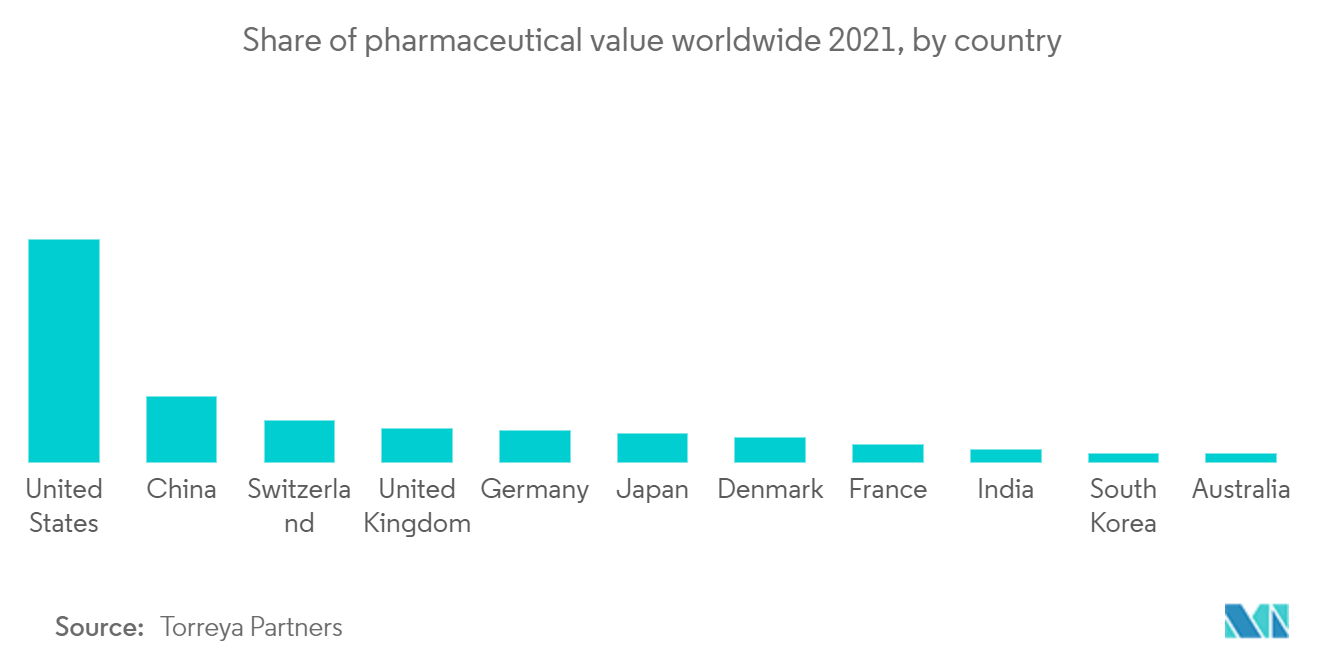
Growing Cold Storage in the United States
Most of the time, the United States is seen as one of the most important markets for developing solutions for managing cold storage processes well.As a result, the market is likely to provide chances for growth in the pharmaceutical sector. Keeping track of pharmaceutical items like vaccines and medications is an expensive process that needs to be done with the right security measures in place to protect the quality of the products.
In 2022, the production stores sector had the biggest share and was expected to grow at the fastest rate, with a CAGR of more than 15.6%. According to the Global Cold Chain Alliance, public storage capacity in the United States accounts for around 75% of total cold storage capacity. Public warehouses help merchants and producers store perishable goods cheaply and make it easier for them to get their goods to customers. The state's 400 million cubic feet of cold storage space, which serves a large customer base, accounts for a sizable portion. Florida, Washington, and Texas are among the industry's leading states, with a considerable market share in 2022. North Carolina and South Carolina are two of the fastest-growing markets, with CAGRs of more than 15.2% and 14.7%, respectively.
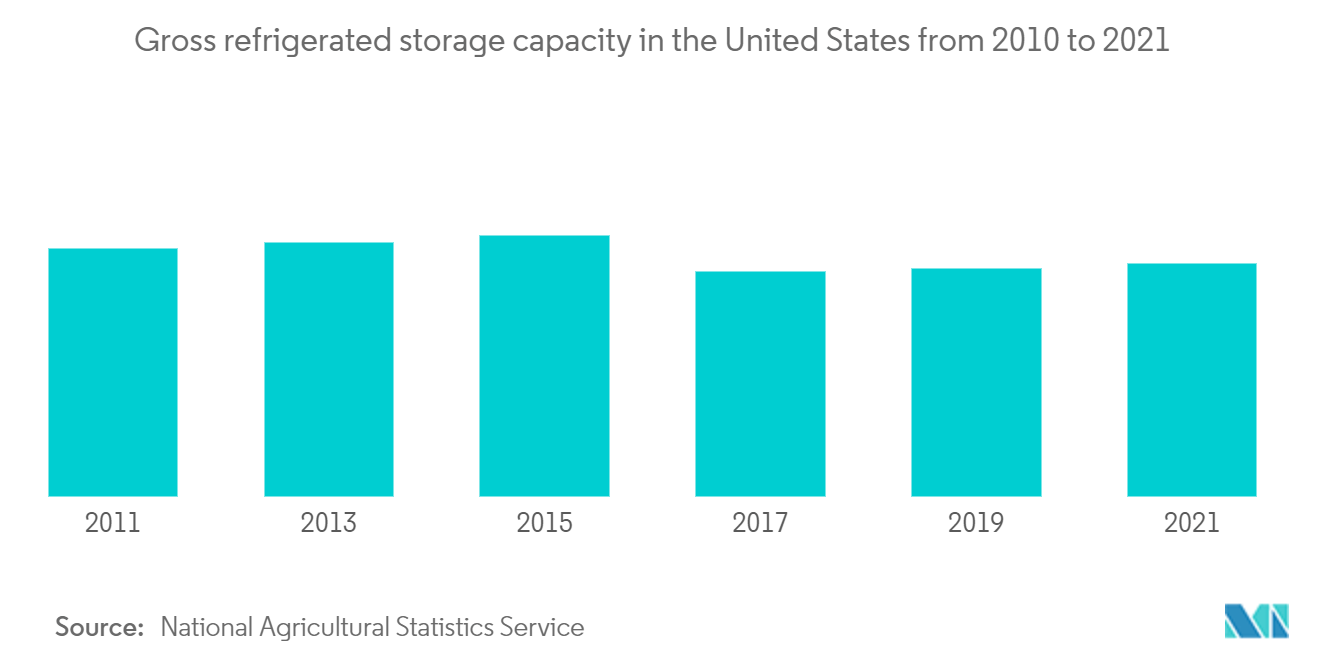
US Pharmaceutical Logistics Industry Overview
Because there are many international and local pharmaceutical logistics companies, the market is very split up.The companies are intensely competing to offer secured supply chain functions and cloud-based supply chain solutions. Additionally, the continuous evolution of pharmaceutical products is encouraging manufacturers to focus on enhancing their product portfolio.
Several big pharmaceutical logistics companies are merging to expand their reach and share their knowledge. As a result, large firms acquire new technologies and expertise while providing smaller vendors with adequate financial and infrastructural support.
US Pharmaceutical Logistics Market Leaders
-
DHL
-
FedEx
-
UPS
-
XPO logistics
-
Hub Group
*Disclaimer: Major Players sorted in no particular order
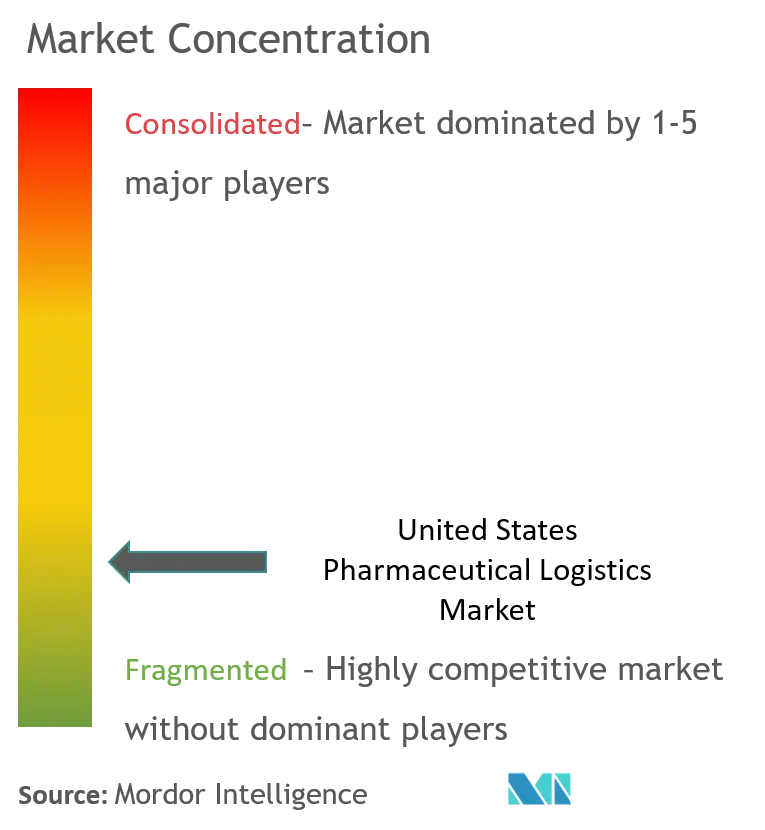
US Pharmaceutical Logistics Market News
- August 2022: Wabash, a provider of transportation, logistics, and distribution solutions, announced the addition of two dealers to its industry-leading North American dealer network. Bergey's Truck Centers and Allegiance Trucks, two of the largest dealers in the Northeast, will be full-line dealers of Wabash parts, services, and equipment, including dry and refrigerated van trailers, dry and refrigerated truck bodies, and platform trailers.
- May 2022: Vertical Cold Storage, a developer and operator of temperature-controlled distribution centers sponsored by real estate asset manager Platform Ventures, has acquired three public refrigerated warehouses in Medley, FL, Marshville, NC, and La Vista, NE, from US Cold Storage.
US Pharmaceutical Logistics Market Report - Table of Contents
1. INTRODUCTION
- 1.1 Study Assumptions
- 1.2 Scope of the Study
2. RESEARCH METHODOLOGY
3. EXECUTIVE SUMMARY
4. MARKET INSIGHTS AND DYNAMICS
- 4.1 Market Overview (Current Market Scenario of Pharmaceutical Logistics Market and Economy)
- 4.2 Government Regulations and Initiatives
- 4.3 Technological Trends
- 4.4 Impact of COVID-19 on the Market (Short-term and Long-term Effect on the Market and Economy)
- 4.5 Overview of Pharmaceutical Industry in the United States
- 4.6 Market Drivers
- 4.7 Market Restraints/Challenges
- 4.8 Market Opportunities
-
4.9 Industry Attractiveness - Porter's Five Forces Analysis
- 4.9.1 Bargaining Power of Buyers/Consumers
- 4.9.2 Bargaining Power of Suppliers
- 4.9.3 Threat of New Entrants
- 4.9.4 Threat of Substitute Products
- 4.9.5 Intensity of Competitive Rivalry
5. MARKET SEGMENTATION (Market Size by Value)
-
5.1 By Product
- 5.1.1 Generic Drugs
- 5.1.2 Branded Drugs
-
5.2 By Mode of Operation
- 5.2.1 Cold Chain Transport
- 5.2.2 Non-cold Chain Transport
-
5.3 By Services
- 5.3.1 Transport
- 5.3.1.1 Road
- 5.3.1.2 Air
- 5.3.1.3 Rail
- 5.3.1.4 Sea
- 5.3.2 Warehousing Services
- 5.3.3 Value-added Services and Other Services
6. COMPETITIVE LANDSCAPE
- 6.1 Overview (Market Concentration Overview, Major Players)
-
6.2 Company Profiles
- 6.2.1 DHL
- 6.2.2 FedEx
- 6.2.3 UPS
- 6.2.4 XPO Logistics
- 6.2.5 Hub Group
- 6.2.6 Expeditors International
- 6.2.7 Penske Logistics
- 6.2.8 SEKO Logistics
- 6.2.9 Nippon Express
- 6.2.10 DB Schenker
- *List Not Exhaustive
- 6.3 Other Companies
7. FUTURE OF THE MARKET
8. APPENDIX
** Subject To AvailablityUS Pharmaceutical Logistics Industry Segmentation
In general, pharmaceutical logistics is about the handling, transport, and management of the supply chain for many different kinds of products, most of which need to be handled in a certain way. The US pharmaceutical logistics market is segmented by product (generic drugs and branded drugs), mode of operation (cold chain transport and non-cold chain transport), and service (transport (road, air, rail, and sea), warehousing services, value-added services, and others). Additionally, the report offers market size and forecasts for the United States pharmaceutical logistics market in value (USD billion) for all the above segments.
| By Product | Generic Drugs | |
| Branded Drugs | ||
| By Mode of Operation | Cold Chain Transport | |
| Non-cold Chain Transport | ||
| By Services | Transport | Road |
| Air | ||
| Rail | ||
| Sea | ||
| By Services | Warehousing Services | |
| Value-added Services and Other Services |
US Pharmaceutical Logistics Market Research FAQs
What is the current United States Pharmaceutical Logistics Market size?
The United States Pharmaceutical Logistics Market is projected to register a CAGR of 3% during the forecast period (2024-2029)
Who are the key players in United States Pharmaceutical Logistics Market?
DHL, FedEx, UPS, XPO logistics and Hub Group are the major companies operating in the United States Pharmaceutical Logistics Market.
What years does this United States Pharmaceutical Logistics Market cover?
The report covers the United States Pharmaceutical Logistics Market historical market size for years: 2019, 2020, 2021, 2022 and 2023. The report also forecasts the United States Pharmaceutical Logistics Market size for years: 2024, 2025, 2026, 2027, 2028 and 2029.
US Pharmaceutical Logistics Industry Report
Statistics for the 2024 US Pharmaceutical Logistics market share, size and revenue growth rate, created by Mordor Intelligence™ Industry Reports. US Pharmaceutical Logistics analysis includes a market forecast outlook 2029 and historical overview. Get a sample of this industry analysis as a free report PDF download.



